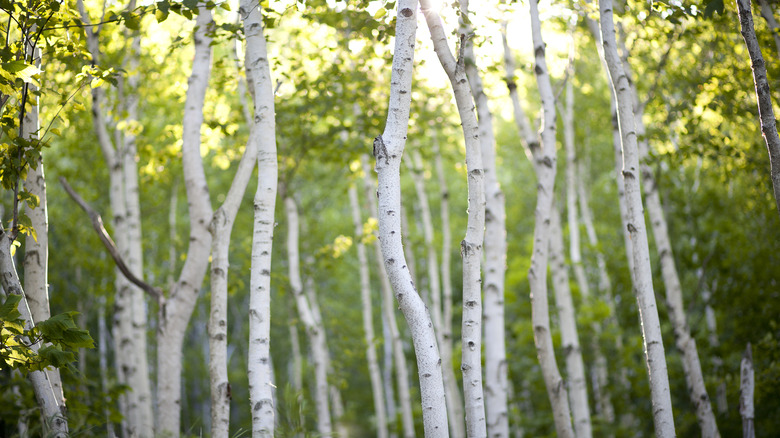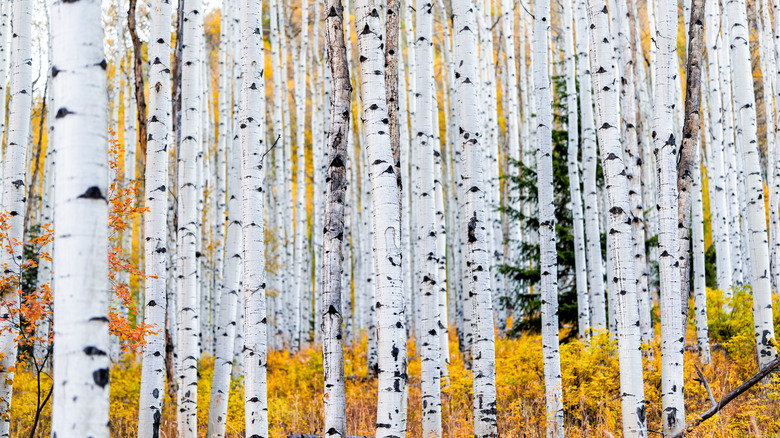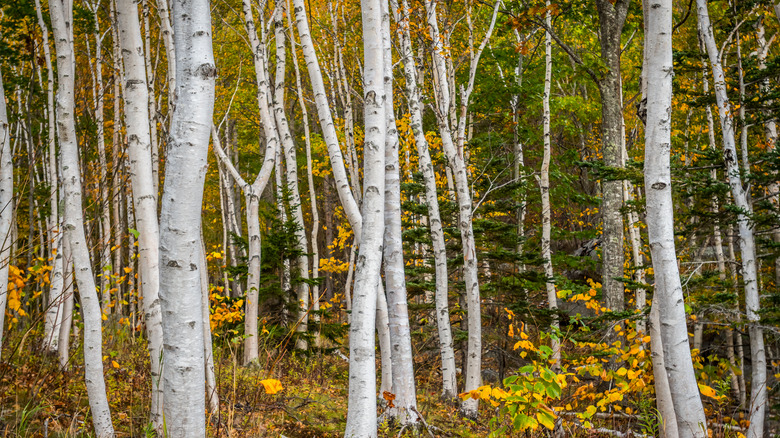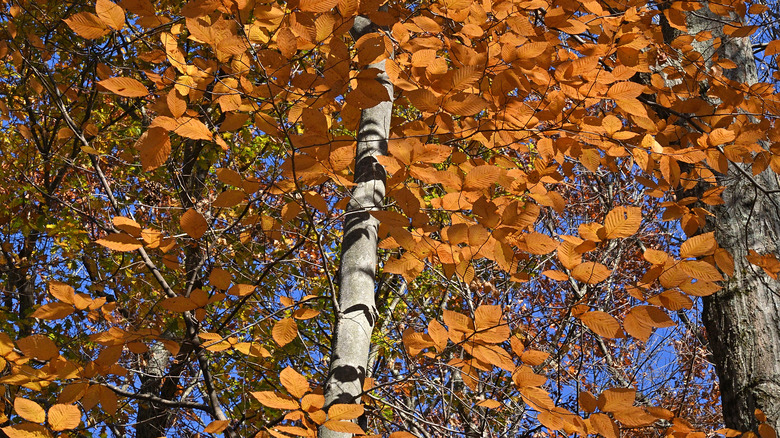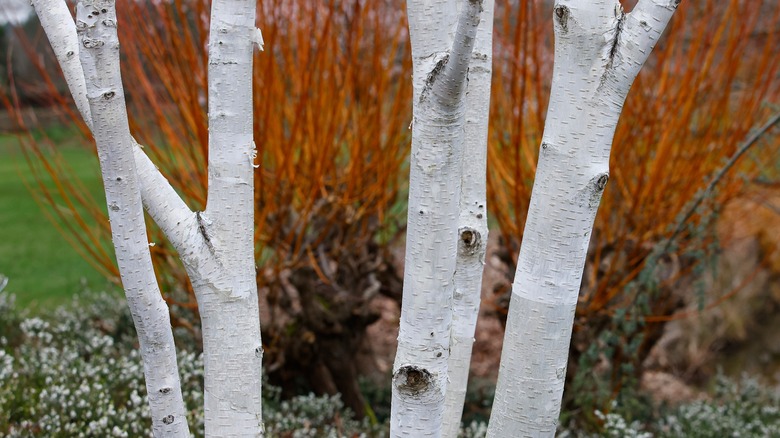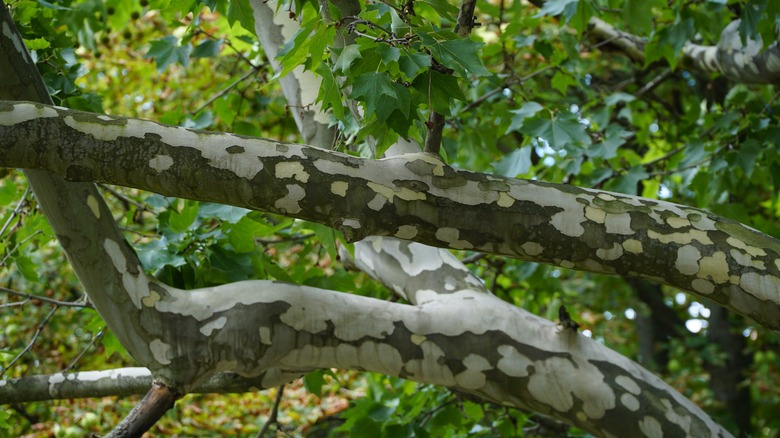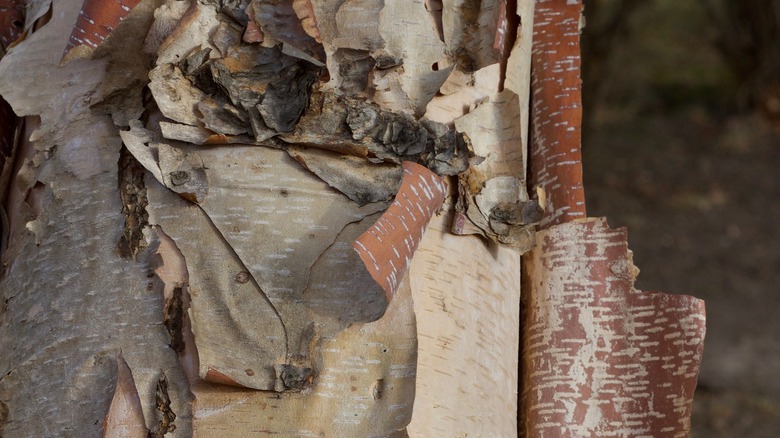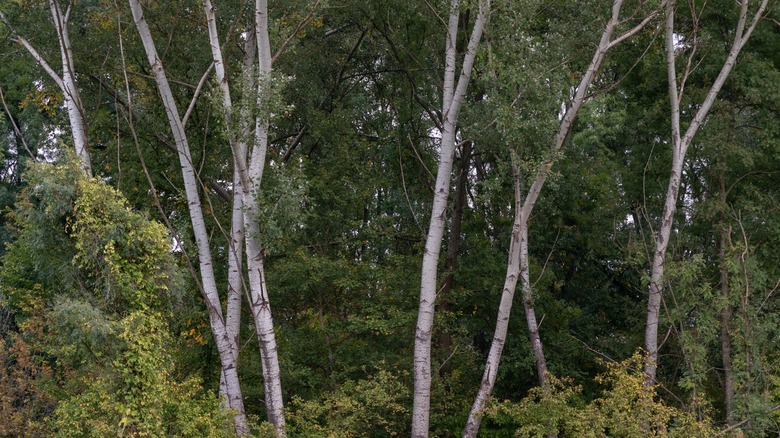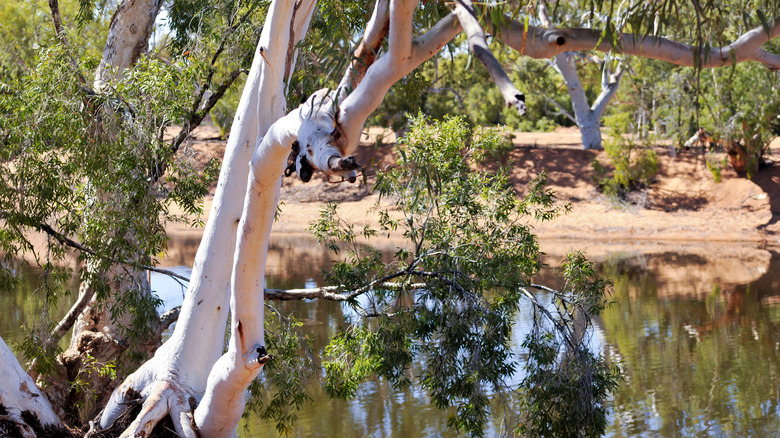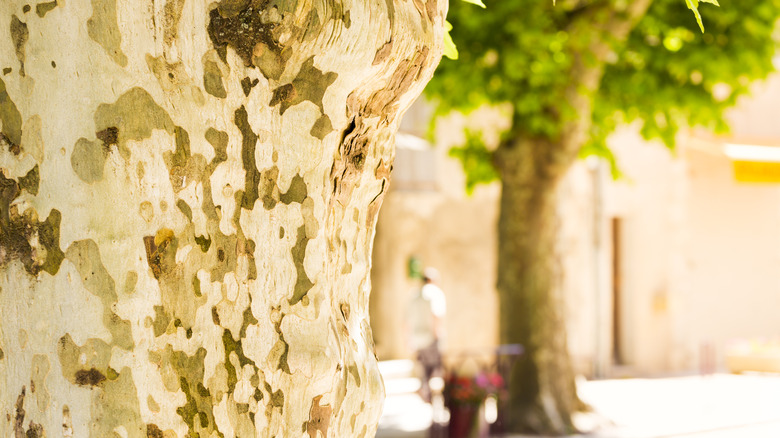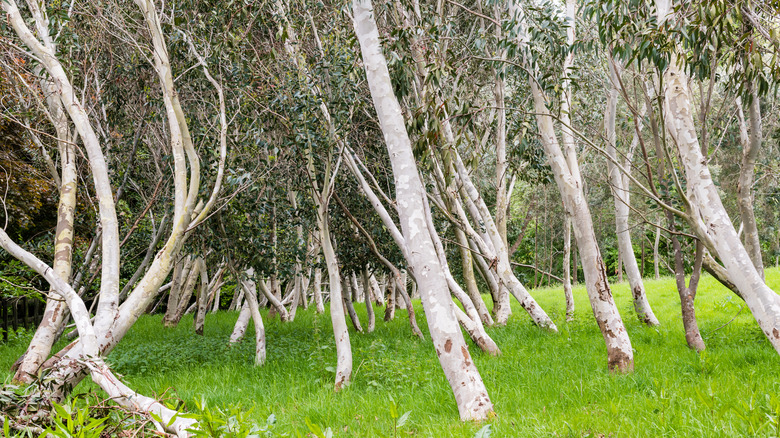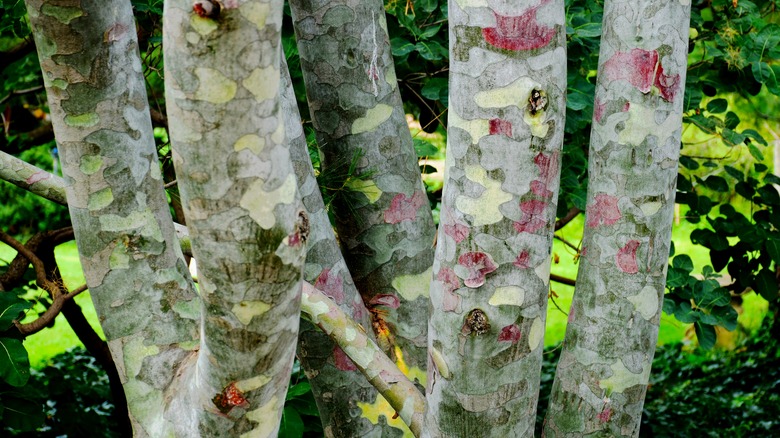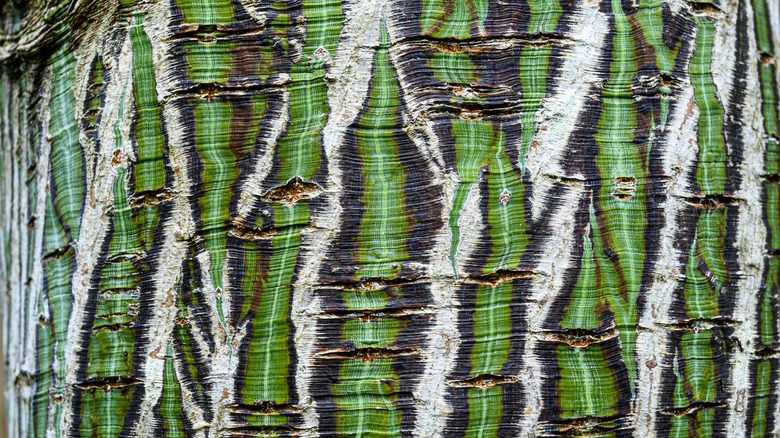12 Gorgeous Trees With White Bark That Create Striking Backyard Contrast
A tree's bark is an underused landscaping element that's often eclipsed in importance by foliage and blooms. Yet the color and texture of trees' bark makes a strong visual statement in any backyard. White bark is particularly effective at making accents and contrasts against a backdrop of lush greenery and colorful flowers, because, well, it stands out.
Alas, white-barked trees aren't planted as often — or as widely known — as their dark-barked counterparts. To inspire you, here are 12 species of trees whose bark comes in various shades of white. These trees readily grow in the United States, although their hardiness zones vary quite a bit. If you have the time and patience to grow any of these majestic species on your property, you'll supplement your assortment of plants with an elegant addition of white color. And since many of these trees live for centuries with proper care, you'll pass down this gift to future generations.
1. Trembling aspen
The trembling aspen (Populus tremuloides, also known as the "quaking aspen") is a native North American tree with smooth, white bark. Its name comes from the leaves' tendency to tremble in light winds — thanks to the flat petioles that connect the leaves to the stem. When mature, their trunks reach over 50 feet in height. The aspens grow quickly, approximately 2 feet per year in good conditions. You can grow and care for aspen trees easily — they are hardy to USDA Zones 1 through 6, love full sun, and grow their best in acidic-to-neutral soils.
2. Paper birch
The paper birch (Betula papyrifera) makes a powerful accent in your backyard. The white bark of mature trees attracts attention among green foliage, while the tall, slender trunks add a vertical dimension to the space. The paper birch thrives in colder regions, and does not fare well in hot, humid summers. It prefers soils with a lower pH, but will tolerate alkaline soils, too. You'll have to keep the substrate thoroughly wet (but well-drained), and allow moisture to accumulate around the roots with organic mulch. With suitable conditions, the paper birch can grow as tall as 70 feet.
3. American beech
The mighty American beech (Fagus grandifolia) is an apt choice for gracing large properties with white trunks and rich foliage. A mature beech reaches widths of over 60 feet and sprouts to heights of 70 feet, so expect an enormous canopy that casts massive shadows and attracts a lots of wildlife. Beeches take a long time to grow, with 20-year-old trees reaching around 13 feet high. They last hundreds of years, however, so the beech you plant today will adorn your home for many generations. Beeches do best in moist, acidic soil in USDA zones 4 through 9.
4. Himalayan birch
The Himalayan birch (Betula utilis) is a suitable option if you're after a tree that stands out with vivid, snow-white bark and adds plenty of shade. The Himalayan birch is known for its unique bark — it's whiter than that of any other common species of birch tree. Although it's native to the Himalayas, these birches are a familiar sight throughout the eastern U.S. That said, the Himalayan birch dislikes heat and humidity. Prolonged exposure to these conditions leaves the trees open to disease and pest infestations. Himalayan birches are best grown in acidic, loamy soil that drains well.
5. Sycamore
Like the beech, the sycamore (Plantanus occidentalis) is a majestic, white-barked addition to any property large enough to accommodate it. These sprawling giants are the biggest deciduous trees east of the Mississippi. Their bark has an off-white color higher up the trunk, while the base is mostly dark-brown. The sycamore is hardy in zones 4 to 9 and is happiest in moist, alkaline soil. For best results, grow your sycamore tree in a spot that gets full sun exposure. With these growing conditions met, sycamore trees can live for the better part of a millennium.
6. River birch
While most birch species loathe hot, humid environments, the river birch (Betula nigra) thrives in steamy locales, which makes it the perfect contrast tree for southern backyards. Its bark isn't exactly white, and usually comes in a mosaic of pink, cream, and light brown. That said, the 'Heritage' cultivar has white bark that's revealed once the older layers exfoliate. These trees grow quite large, with canopies as wide as 40 feet and tall trunks reaching 80 feet in height. Like other birches, this species flourishes if you grow it in acidic soil and water it generously.
7. European poplar
The European poplar (Populus tremula) is a close sibling of the trembling aspen, and shares many characteristics with it. Like its trembling aspen cousin, the European poplar grows quite tall and has white-colored bark that's only a bit darker than aspen's. You can plant this tree anywhere within USDA Zones 1 to 6, although it flourishes in cooler climates and can become susceptible to various illnesses in heat and humidity. For best results, plant this poplar in a location that gets full sun and has nutrient-rich, well-draining soil.
8. Ghost gum tree
If you live in the nation's warmest regions, the ghost gum tree (Corymbia papuana) is an excellent candidate for adding some white color to your yard in a way that will stand out. This eucalyptus species hails from Australia, where its sleek, white bark, slender leaves, and white flowers can be seen in abundance in the bone-dry central regions. In the U.S., you can grow the ghost gum in USDA zones 9 through 11. The tree prefers dry conditions and full sun and tolerates a diverse range of soils types.
9. Plane tree
The plane tree (Platanus x acerifolia) is a large deciduous tree that looks like the sycamore. The resemblance is not surprising, since the plane tree is a hybrid of the sycamore and oriental plane. The tree has patchy bark with an assortment of colors, ranging from white to reddish-gray. As the older layers peel off, the inner white bark comes into view. Given the plane tree's enormous size of roughly 100 by 80 feet, it's an excellent option for creating shade in your backyard. The plane tree likes moist soil that drains well and thrives in full sun.
10. Snow gum eucalyptus
The snow gum eucalyptus (Eucalyptus pauciflora) is a small tree with lots of character. Its bark peels in patches to festoon the trunk in colors that include white, gray, purple, and green. The trunks themselves twist into unique shapes as they grow to give the tree a surreal look. While the snow gum eucalyptus is native to Australia, you can grow them anywhere in USDA zone 7 and above. The trees will tolerate bouts of cold. The snow gum eucalyptus performs best when exposed to full sun and watered regularly. However, mature trees can withstand drought.
11. Lacebark pine
The lacebark pine (Pinus bungeana) is your coniferous go-to option for beautifying your property with touches of white. This pine's bark is not uniformly white, though. Its speckled, peeling nature leaves a medley of white, gray, green, and salmon colors on the trunk, which gradually become off-white or silver. Lacebark pine grows slowly, and reaches heights of over 30 feet, along with 30-foot cover, at maturity. To aid the tree's growth, plant it in alkaline soil in a spot that gets full sun for at least six hours every day. The soil should stay moist without retaining water.
12. Snakebark maple
Maples are known and loved for their distinct leaves and vibrant fall colors, but the snakebark maple (Acer pensylvanicum) stands out with its unique, ridged bark. On mature maples, the bark is made up of white and green, vertical stripes, which coexist in a striking contrast on the tree's trunk. The snakebark maple is happiest in cooler climates, and is hardy in USDA zones 3 to 7. It likes shade, and too much sun will scorch its leaves. You'll have to water young trees regularly, whereas mature trees only need irrigation during lengthy droughts.
